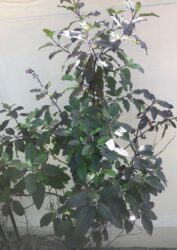By Johnny Coomansingh
During my research activities in Trinidad, I come across some interesting features on the landscape. The tulsi shrub (Ocimum tenuiflorum) caught my attention. I will like to introduce you to this wonderful plant, but first, allow me to chat a little about how this plant came to be growing in Trinidad and Tobago.
Trinidad and Tobago is the southernmost, English-speaking, democratic state in the Caribbean region. Situated just 11.2 kilometres (seven miles) east of Venezuela, the country consists of the larger island Trinidad, and the smaller island Tobago which lies about 35.4 kilometres (22 miles) northeast of Trinidad. The country boasts of a rich culture forged from the many groups of people who arrived on its shores after its rediscovery by Christopher Columbus in 1498.
Because of the many ethnicities that migrated voluntarily and involuntarily to these shores, Trinidad and Tobago became a multi-racial, multi-religious and polyrhythmic state. West Africans were involuntarily brought to Trinidad during the Slave Trade era to satisfy the supply of labor for sugar cane plantations. Liseli Fitzpatrick in her paper: “Slavery and the Preservation of African Traditions & Customs in Trinidad & Tobago“ (Paper presented at the annual meeting of the 33rd Annual National Council for Black Studies, Atlanta, GA, 30/11/2014) explained:
“The arrival of Africans to Trinidad and Tobago brought with it a people who were determined to carry on their traditions, which were not an easy task since the penalty, if caught, could result in death. Africans’ ability to preserve their culture in Trinidad and Tobago has been manifested in national festivals, music, dance, religious rituals and customs, such as Carnival, Calypso, Bongo, Rada, Shango, Orisha, Spiritual Baptist and its ceremonial wear, Limbo, Kalinda (stickfighting), tamboo-bamboo (leading to the creation of steelpan instrument), and certain foods and drinks such as coo-coo, mauby, chillibibi, and tom-tom (pound plantain) to name just a few of the influences.”

However, apart from the Africans, thousands of Indian indentured servants of the British Crown voluntarily migrated to Trinidad after the emancipation of enslaved Africans in 1834. The arrival of South Asians (East Indians) began in 1845. Indentured servants comprised religious persuasions of both Muslims and Hindus. Professor Wilbur Zelinsky, world-famous cultural geographer, coined the term “cultural baggage” which describes what people bring with them when they migrate.
Many migrants are more concerned with the mentifacts they take along, that part of their lifestyle; the most protected psychological or cerebral aspects of their being. Religion, language, art, music, and magic fall within this mentifactual category of culture. As it follows, the South Asians, in particular those of the Hindu persuasion, brought aspects of their culture that were more tangible than that of the Africans because they had the “freedom” to bring with them what they cherished most. In his article, “A Passage of Indian Ancestral History in Trinidad and Tobago,” Paras Ramoutar indicated: “They came with Ramayana, Hanuman chalisa, Satnarine Poti, tulsi plants, and mango trees.”
Tulsi, tulasi, holy basil or “jumbie basil” is a sacred plant in Hindu belief. Hindus regard it as an earthly manifestation of the goddess Tulsi, a consort of the god Vishnu. The offering of its leaves is mandatory in ritualistic worship of Vishnu and his forms like Krishna and Vithoba. Frederick J. Simoons (1998) in his book titled: “Plants of life, plants of death.” (University of Wisconsin Press, pp. 7–40), stated:
“While tree worship is not uncommon in Hinduism, the tulsi plant is regarded the holiest of all plants. The tulsi plant is regarded as a threshold point between heaven and earth. A traditional prayer tells that the creator-god Brahma resides in its branches, all Hindu pilgrimage centers reside in its roots, the Ganges flows through its roots, all deities in its stem and its leaves and the Hindu scriptures – the Vedas in the upper part of its branches. It is considered as household god particularly referred as a “Women’s deity”. It is called as “the central sectarian symbol of Hinduism” and Vaishavas consider it as “the manifestation of god in the vegetable kingdom.”
In Hindu holy epics and scriptures, the Bhagavata and Mahabharata, the tulsi plant is regarded to be the reincarnation of Tulsi a goddess and devotee of Lord Vishnu. The shrub is used in almost every ritual in Hinduism and its presence around Hindu homes is quite ubiquitous. Speaking of the power of this plant, Lord Vishnu remarked: “O Narada! Every house, every village, every forest, wherever the plant of tulsi is grown, there misery, fear, disease, and poverty do not exist. Tulsi in all places is holier than holy.” For this reason, many Hindu parents place a tulsi plant outside their children’s window when they are studying for exams. It is also grown near to the jhandi (prayer flags) and at the entrance of homes to cleanse and purify the environment. It has been said the tulsi plant repels the evil eye, something known as maljo (from the French mal yeux which means “bad eye”) in Trinidad.
Cultivated and venerated for over 5,000 years in the South East Asian tropics, tulsi served as a plant for healing in that region. In Sanskrit, it is translated as “the incomparable one.” Tulsi is worshipped as the avatar of the Hindu Goddess of Light, Lakshmi. In terms of medicinal uses, tulsi is used in the Ayurvedic form of medicine. Some people believe that they receive healing by drinking tulsi water. Some say, “tulsi water is like life water.” Among some of the benefits, it is thought that tulsi drives away insects and snakes.
Decoctions of tulsi leaves is also used to calm the symptoms of the common cold, bronchitis, and respiratory infections. The plant contains adaptogens, chemicals that fight free radicals in the human body, a kind of anti-oxidant that aids in the relief of stress and tension. Tulsi also has the potential to alleviate skin diseases, disorders of the ear, nose, and throat, toothache, bad breath, migraines, and headache.
For many centuries, tulsi, otherwise known as the queen of herbs, has been known for its remarkable healing properties. Tulsi is taken as a herbal tea. The oil extracted from the Karpoora Tulsi is mostly used in herbal toiletry. Its oil is also used against insects and bacteria. The Rama Tulsi is the effective remedy for severe Acute Respiratory Syndrome. Tulsi oil is also used as an ear drop. Tulsi helps in curing malaria. It is very effective against indigestion, hysteria, insomnia, and cholera. The fresh leaves of tulsi are taken by millions of people every day.
Worldwide, many people wear tulsi beads, which is said to have certain physical and medicinal properties. Tulsi wood is considered as more powerful than any other gem that helps in protecting one from negative influences. Symbolizing purity, tulsi is the sacred plant very dear to the Lord Vishnu. Deriving its name from Tulasi Devi, an eternal consort of Lord Krishna, tulsi is considered as one of the holiest plants on the Indian subcontinent. In India and in Trinidad, people grow tulsi as a religious plant. Many Hindu devotees worship it. Its leaves are used in temples for worship purposes and also in several rites such as marriage. According to the ancient scriptural texts, tulsi is glorified as the one who helps in bringing people closer to the divine.
There is much more to relate about the tulsi plant and its value to the culture of Trinidad and Tobago, but from this snippet we have learnt that culture is not static; culture moves from place to place…a process known as cultural translocation. Culture goes hand in hand with migration. When people travel, whether voluntarily or involuntarily, their cultural baggage accompanies them wherever they go. The tulsi plant came to Trinidad and Tobago with the arrival of East Indian indentured servants of the British Crown. It is now a plant that has found root in the twin-island state; a literal holy icon in a plural society.





